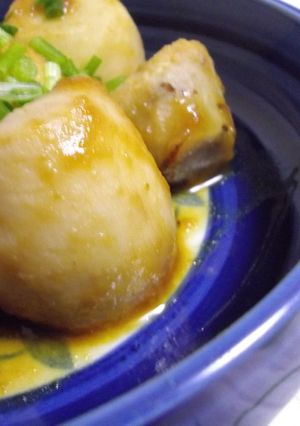Simmered Taro with Kintoki Ginger Powder

Warm your body with the hot power of ginger♪
The origin of this recipe
I created this recipe by adding Kintoki ginger to the usual simmered taro to help get through the cold winter.
Cooking Instructions
- 1
(Preparation)
- Wash the taro roots well and cut a small portion off the top.
- Mix the ● ingredients together. - 2
Place the taro roots with the cut side down in a frying pan, add 1 1/2 cups of water, cover, and bring to a boil over high heat.
- 3
Once boiling, reduce the heat and steam for 10 minutes. *Do not overcook; it's okay if they feel a bit firm when pierced with a skewer.
- 4
Once cooled, peel the taro roots, rinse to remove the sliminess, and drain.
- 5
Add the dashi broth and the peeled taro to the pan, cover, and cook over medium heat, occasionally rolling them around, for about 7 minutes.
- 6
Add the ● mixture, bring to a boil, then simmer over low heat until the liquid thickens and evaporates.
- 7
Sprinkle with chopped green onions and serve.
Reactions
Cooksnaps
Did you make this recipe? Share a picture of your creation!
Written by
Similar Recipes
-

Simmered Taro Simmered Taro
When I use dashi powder to make this, I can get proper hardness and texture of taro. The key point of this recipe is to pour water not from the beginning but after stir-frying. And add mirin right before turning off the heat.
-

Simmered Kiriboshi Daikon & Pork Belly with Ginger and Taro Root Simmered Kiriboshi Daikon & Pork Belly with Ginger and Taro Root
I learned a hint when I was browsing a magazine in the book store. There were two recipes, "Simmered Kiriboshi Daikon & Pork Belly" and "Simmered Kiriboshi Daikon & Taro Root," so I mixed the two recipes' ingredients together and added my own flavors.Be careful not to discard the kiroboshi daikon soaking water. Recipe by Setsubunhijiki
-

Simmered Taro and Pork Belly Simmered Taro and Pork Belly
Creamy taro absorbs the flavors from the pork belly, making it a delicious autumn side dish.The origin of this recipeThe idea came from thinking, 'Taro and pork obviously go well together. Using pork slices is more convenient than a whole piece.' Translated from Cookpad Japan
Translated from Cookpad Japan -

Simmered Taro in Rich Oyster Sauce Simmered Taro in Rich Oyster Sauce
I wanted to enjoy a tasty dish of simmered taro and lotus potatoes.Just put everything in the pan and simmer. Just add chicken stock powder and oyster sauce to a regular simmered dish for a different taste.If you have time, let cool so the flavours meld. Recipe by Jina shufu
-

Yamagata-Style Stewed Taro Root Yamagata-Style Stewed Taro Root
This taro root simmer is a regional dish of Yamagata. To be honest I've never eaten it...I heard that the flavor and the stock differs depending on the household and the region, so I made this taro root simmer to my liking.A light flavor that lets you enjoy drinking the soup as well. Adjust the flavor to your liking. Add the burdock root as is without soaking in water. For serving 4. Recipe by Happytonakai
-

Easy Simmered Taro Roots and Squid Easy Simmered Taro Roots and Squid
I never ate much simmered food as a child, but as I grew up, I came to understand how delicious it can be.I make this all the time in the winter.The squid will go tough if you overcook it.Since the squid is simmered again with the satoimo at the end, be quick seasoning it in Step 2.You can get a great aroma by grating Yuzu peel and sprinkling it on top. Recipe by Nanamama
-

Delicious Simmered Taro Root & Thinly-Sliced Pork Delicious Simmered Taro Root & Thinly-Sliced Pork
This is a go-to recipe in the fall and winter when I receive plenty of taro roots. I made this when I was getting tired of dashi and sweet and sour flavors. You can make this and set it aside for later, making this work for a bento lunch box item as well.The key to the flavor is the Japanese sake and the mirin. For the Japanese sake, you can use the carton type, but please be sure to use authentic mirin. If you use mirin-style flavoring or cooking sake, they have salt, and with this amount the whole thing will become salty. If you don't have options, then reduce the soy sauce to 1 teaspoon. Recipe by Umakappe
-

Well-Flavoured Simmered Taro Roots, Daikon Radish, and Squid Well-Flavoured Simmered Taro Roots, Daikon Radish, and Squid
It's our family's staple dish using the combination of taro root, daikon radish, and squid.If you simmer the squid too long, it gets hard, so please take it out after getting the dashi from it. I kept a little bit of sticky texture from the taro root by omitting the parboiling process. Recipe by Midofadobeshi
-

Easy Stir-Fried Satoimo (Taro) and Konnyaku Easy Stir-Fried Satoimo (Taro) and Konnyaku
I wanted to make a quick and easy simmered dish.Satoimo (taro) and konnyaku are foods which require no prepping. Recipe by Marimy
-

Simmered Eggplant and Myoga Ginger Simmered Eggplant and Myoga Ginger
I got a large amount of autumn eggplant and myoga ginger from my neighbor. I often make simmered eggplant with a moderate firmness that isn't too thick. When I changed the amounts it turned out like this.Work quickly so that the fragrance of the myoga ginger remains.Because the eggplant is lightly boiled, it isn't necessary to use as much oil as usual to remove the bitter taste. (You can also place the eggplant in water and heat in a microwave.)Adjust the amount of stir-frying oil and soy sauce according to your preference. Recipe by Kechauru recipe
-

Stewed Taro Potato Soboro Tumble Stewed Taro Potato Soboro Tumble
The hungry boys in my family gobble up my basic tumble stew when I add meat.Crinkle aluminum foil and spread it out; this is a drop lid, so the crinkles will pick up the surface scum, without you manually skimming. Adjust the pre-boiling and boiling time according to the size of the taro potatoes. Recipe by kebeibiko.
-

Simmered Atsuage with Sweet & Salty Ginger Simmered Atsuage with Sweet & Salty Ginger
I wanted to eat a simple simmered dish, so I made this without meat, just atsuage and ginger.You can make a lot and store it. The flavors settle in if you let it cool down once, so it tastes even better after it has been reheated. Recipe by Raby



